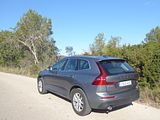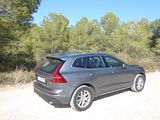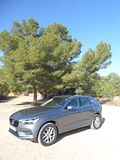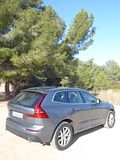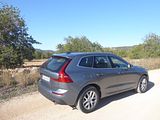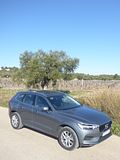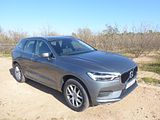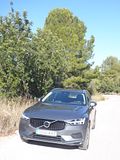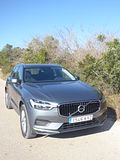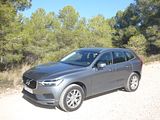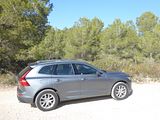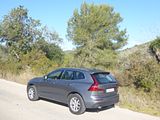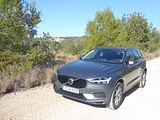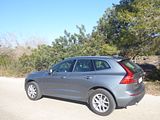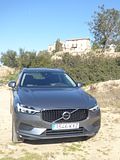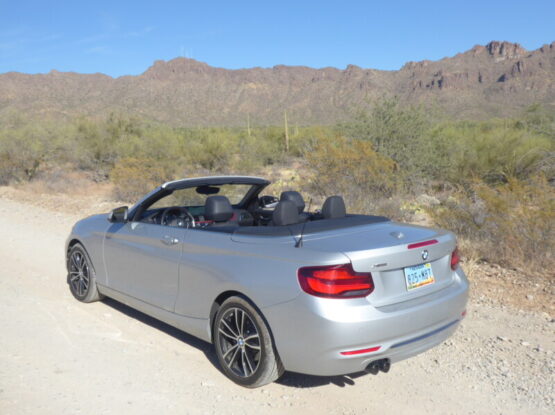Although Volvo still have a couple of large estate car models in their range, the V60 and V90, and for many these still epitomise this well-respected Swedish brand, the reality is that, just as has become the case for almost all manufacturers these days, it is the crossover models which are the most important offerings and the ones that sell in the largest quantities. Volvo scored a proverbial bull’s eye with their first such, the XC90 back in 2002, and so it was no surprise that they followed it up with a slightly smaller car, the XC60. Although chasing a larger sales opportunity, it also had a longer list of rivals, and it is fair to say that the first XC60 did well, but it did not perhaps stand out quite as much as its larger stablemate, though notably, it achieved its strongest sales in the last year of production. A second generation XC60 was launched in 2017 and it did not deviate much from the formula of the first. Based on the same SPA platform as the larger XC90, the new model was slightly longer, wider and lower than the first, and it boasted the latest family-style looks, with those Thor headlights and incorporated all the latest technology that we are told buyers want including a lengthy list of safety features. I never managed to test the first generation XC60, but have been able to secure one of the latest cars thanks to Hertz Espana who had one with my name on it when I arrived in Barcelona for a weekend of winter sunshine.
The XC60 is available with a variety of petrol, diesel and hybrid powertrains, all of them with four cylinders and these are now identified with a model type which starts T, D or B respectively. The number that follows simply denotes a relative amount of power. There have been a number of changes to the available engines since that 2017 launch, not least as the market has evolved from the relatively diesel-centric world of 2017 to one now where hybrid is increasingly important. At launch there were three choices: the D4 (188bhp) and D5 (231 bhp) diesels and the 254 bhp T5, all of which came with standard all-wheel drive and an eight speed automatic gearbox. Later that year, a T8 Twincharge option arrived, which thanks to the addition of an electric motor had an impressive total of 421 bhp at its disposal. In early 2019, Volvo added some mild hybrid models to the range. These use Volvo’s advanced kinetic energy recovery braking system, which is coupled with its existing internal combustion engines to create a new integrated electrified powertrain, under its new ‘B’ badge. The B5 comes as mild hybrid petrol or diesel variant, a B4 diesel mild hybrid as well as a B6 petrol mild hybrid. The B5 petrol is available with front wheel drive or all-wheel drive. Volvo also upgraded its existing T8 and T6 Twin Engine plug-in hybrid powertrains, while at the same time confirming that plug-in options would now be available on every model it produces. This new powertrain, electrified via brake-by-wire energy recovery, offers drivers up to 15 per cent fuel savings and emission reductions in real world driving. The new brake-by-wire system interacts with the energy recovery system and reduces fuel consumption and emissions by recovering kinetic energy under braking. The upgraded T8 Twin Engine plug-in hybrid with up to 420PS features a new battery and brake-by-wire advanced battery charging. The range of the T8 powertrain has increased by around 15 per cent and this powertrain is available on all 90 and 60 Series cars. An upgraded version of the smaller capacity T6 Twin Engine plug-in hybrid is also combined with the new battery and brake-by wire-technology. This powertrain also offers an approximate 15 per cent range increase and is available on the V60 estate and S60 sedan. Confusing? Yes, but then most model ranges are, these days.
Luckily there was no to guess which engine powered my test car, as there was a badge on the boot, reading D4, which means the least powerful XC60 on offer. It gives you 188 bhp from its 2 litre four cylinder engine. Generally, this engine was very refined with almost no trace of the once characteristic diesel sounds, either on start-up or when accelerating. Thanks to the available torque the XC60 can gather speed nicely, though this is more a brisk rather than a fast car, but that is probably entirely in keeping with its target market. More importantly, the car is quiet once underway with all noise sources well suppressed. It is always smooth and the well-matched eight speed auto box goes about its job unobtrusively. The car features a start/stop system which proved a bit too keen to cut out, thus making it hard to manoeuvre sometimes. I covered 310km in the time I had the car and it needed 20.83 litres to refill it. The trip computer suggested an average of 5.8 to 6 l/100km and this may be more accurate than my data as of course I had no whether it was really as full when I collected it as it was when I returned it. The maths say I did 42.23 mpg. Perhaps more impressively, the car also advised that the range was 1250km, which is an awfully long day without need to refuel. The Volvo does not make the same pretence of being sporting unlike some of its (German) rivals, and the results seems more comfort oriented than anything else. On the standard 235/60 R18 tyres, the XC60 rides well. It is still decent enough to drive. There steering is light but not unduly so, with some feel to it. It has plenty of grip and the handling is predictable tending to understeer as you get more enthusiastic, which is when some body roll will also be evident. The brakes proved powerful and effective. There is an electronic handbrake, as is generally the way these days. All round visibility is mostly fine, and the rear parking sensors helped when reversing.
Volvo has built quite a reputation for producing among the nicest quality and classiest interiors of almost any brand and the XC60 continues that tradition. The materials used are all of superlative quality, though the inside of this one was very black with just some grey metal effect insets, but you can configure other trim types and colours. The leather-wrapped wheel was particularly nice to hold, in a way that so many cars just are not. The instrument binnacle looks clean and neat, with two large dials for speedometer and rev counter with a fuel gauge inset in the lower part of the rev counter. The display area in between the dials can be used for navigation as well as other trip data. There are some chunky column stalks for indicators, lights and wipers, again, which just felt nice to use. Buttons for cruise control and audio repeaters are where you need them, on the wheel spokes. The centre of the dash area is dominated by a portrait style 9” info touch screen for Volvo’s Sensus system, which sits between the central air vents. Navigation is included as standard. This is not quite as intuitive as some systems when you first get into a Volvo, but familiarity soon made it relatively straight-forward, though like so many of these latest systems, I found it almost impossible to use safely whilst on the move. Like many other brands, Volvo have done away with most of the buttons, so you do have to use the screen, whether you like it or not. There is not much in the centre console, though this is where the twist-to-start knob is located and there is still a conventional gearlever.
Seat adjustment for fore/aft position and backrest angle is manual, whereas there is an electric motor for altering the height. There are height adjustable seat belts and the steering column telescopes in/out and up/down over a wide range so it was easy to get the perfect driving position to suit my proportions. The seats themselves in this trim had leather outers and a cloth centre. Like all Volvo models, they are carefully and orthopoedically shaped and so proved extremely comfortable.
Space for those in the back seats is generous. There is lots of legroom, even with the front seats set well back and the crossover styling means that there is especially generous headroom. The central console comes back a certain way, but there should still be sufficient leg room for a middle seat occupant. There is a drop down central armrest with cupholders in the upper surface. Oddments can be put in the door bins or the map pockets on the back of the front seats.
The boot is also a good size, though in raw numbers, it is not quite as large as that of most of its direct rivals. The tailgate is electrically assisted, which is always useful given the size of the tailgate on vehicles of this size. As well as the main boot area, there is also a useful stowage area under the floor. The rear seat backrests are asymmetrically split and simply drop down to create a long and flat load platform. Inside the cabin, there is a huge glovebox which includes a useful upper shelf, and there is also a lidded cubby area as well as the space under the central armrest as well as useful pockets on the doors.
The Volvo XC60 comes in four trims: Momentum, R-Design, Inscription, and Polestar Engineered. The T5 is the only engine that can be paired with front-wheel drive (all-wheel drive was available with this engine when the vehicle was new). AWD is standard with the Diesels, T6 and T8 and the Hybrid cars. An eight-speed automatic transmission is the only available gearbox. The base XC60 Momentum trim comes well-equipped and features plenty of infotainment and driver assistance technology. It also boasts a comfortable, premium interior, making it an excellent value. Features include dual-zone automatic climate control, a panoramic moonroof, a 9-inch touch screen, Apple CarPlay, Android Auto, Bluetooth, navigation, and a 10-speaker audio system. Standard active safety features include run-off road mitigation and protection, oncoming lane mitigation, driver drowsiness monitoring, collision mitigation with active braking, traffic sign recognition, lane keep assist, and a rearview camera. The XC60 R-Design builds off the amenities of the Momentum trim, adding a 14-speaker Harman Kardon sound system, front and rear parking sensors, active park assist, blind spot monitoring, proximity keyless entry, and power-folding head restraints and seats in the second row. It also boasts a sportier appearance, with unique styling elements such as a special grille and larger wheels, cloth and leather sport seats, and R-Design badging. The XC60 Inscription has the same features as the R-Design, aside from that trim’s exclusive sports aspects, and adds quad-zone automatic climate control, driftwood trim, Nappa leather upholstery, and navigation. The XC60 Polestar Engineered features the T8 plug-in-hybrid powertrain with an additional 15 horsepower. The Polestar also has some unique styling touches. Each trim can be upgraded to Pro spec which adds a heated front windscreen and steering wheel, along with active-bending headlights.
I rather liked the XC60. It epitomises typical Volvo attributes, of comfort and safety with a high quality finish and an appeal that is perhaps more subtle but probably also more enduring than some of its brasher rivals. That won’t be for everyone, of course, but for those who want a spacious family car that they are proud to own, and that by all accounts I likely to prove reliable, the XC60 has much to commend it.



